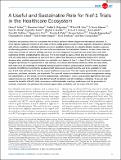A Useful and Sustainable Role for N‐of‐1 Trials in the Healthcare Ecosystem
Author(s)
Selker, Harry P; Cohen, Theodora; D’Agostino, Ralph B; Dere, Willard H; Ghaemi, S Nassir; Honig, Peter K; Kaitin, Kenneth I; Kaplan, Heather C; Kravitz, Richard L; Larholt, Kay; McElwee, Newell E; Oye, Kenneth A; Palm, Marisha E; Perfetto, Eleanor; Ramanathan, Chandra; Schmid, Christopher H; Seyfert‐Margolis, Vicki; Trusheim, Mark; Eichler, Hans‐Georg; ... Show more Show less
DownloadPublished version (166.7Kb)
Publisher with Creative Commons License
Publisher with Creative Commons License
Creative Commons Attribution
Terms of use
Metadata
Show full item recordAbstract
Clinicians and patients often try a treatment for an initial period to inform longer-term therapeutic decisions. A more rigorous approach involves N-of-1 trials. In these single-patient crossover trials, typically conducted in patients with chronic conditions, individual patients are given candidate treatments in a double-blinded, random sequence of alternating periods to determine the most effective treatment for that patient. However, to date, these trials are rarely done outside of research settings and have not been integrated into general care where they could offer substantial benefit. Designating this classical, N-of-1 trial design as type 1, there also are new and evolving uses of N-of-1 trials that we designate as type 2. In these, rather than focusing on optimizing treatment for chronic diseases when multiple approved choices are available, as is typical of type 1, a type 2 N-of-1 trial tests treatments designed specifically for a patient with a rare disease, to facilitate personalized medicine. While the aims differ, both types face the challenge of collecting individual-patient evidence using standard, trusted, widely accepted methods. To fulfill their potential for producing both clinical and research benefits, and to be available for wide use, N-of-1 trials will have to fit into the current healthcare ecosystem. This will require generalizable and accepted processes, platforms, methods, and standards. This also will require sustainable value-based arrangements among key stakeholders. In this article, we review opportunities, stakeholders, issues, and possible approaches that could support general use of N-of-1 trials and deliver benefit to patients and the healthcare enterprise. To assess and expand the benefits of N-of-1 trials, we propose multistakeholder meetings, workshops, and the generation of methods, standards, and platforms that would support wider availability and the value of N-of-1 trials.
Date issued
2021-09-22Department
Massachusetts Institute of Technology. Center for Biomedical Innovation; Massachusetts Institute of Technology. Department of Political Science; Sloan School of ManagementJournal
Clinical Pharmacology & Therapeutics
Publisher
Wiley
Citation
Selker, Harry P, Cohen, Theodora, D’Agostino, Ralph B, Dere, Willard H, Ghaemi, S Nassir et al. 2021. "A Useful and Sustainable Role for N‐of‐1 Trials in the Healthcare Ecosystem." Clinical Pharmacology & Therapeutics.
Version: Final published version